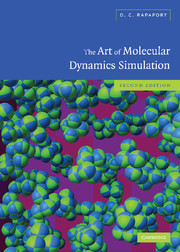Book contents
- Frontmatter
- Contents
- Preface to the first edition
- Preface to the second edition
- About the software
- 1 Introduction
- 2 Basic molecular dynamics
- 3 Simulating simple systems
- 4 Equilibrium properties of simple fluids
- 5 Dynamical properties of simple fluids
- 6 Alternative ensembles
- 7 Nonequilibrium dynamics
- 8 Rigid molecules
- 9 Flexible molecules
- 10 Geometrically constrained molecules
- 11 Internal coordinates
- 12 Many-body interactions
- 13 Long-range interactions
- 14 Step potentials
- 15 Time-dependent phenomena
- 16 Granular dynamics
- 17 Algorithms for supercomputers
- 18 More about software
- 19 The future
- Appendix
- References
- Function index
- Index
- Colophon
10 - Geometrically constrained molecules
Published online by Cambridge University Press: 28 February 2011
- Frontmatter
- Contents
- Preface to the first edition
- Preface to the second edition
- About the software
- 1 Introduction
- 2 Basic molecular dynamics
- 3 Simulating simple systems
- 4 Equilibrium properties of simple fluids
- 5 Dynamical properties of simple fluids
- 6 Alternative ensembles
- 7 Nonequilibrium dynamics
- 8 Rigid molecules
- 9 Flexible molecules
- 10 Geometrically constrained molecules
- 11 Internal coordinates
- 12 Many-body interactions
- 13 Long-range interactions
- 14 Step potentials
- 15 Time-dependent phenomena
- 16 Granular dynamics
- 17 Algorithms for supercomputers
- 18 More about software
- 19 The future
- Appendix
- References
- Function index
- Index
- Colophon
Summary
Introduction
Some internal degrees of freedom are important to molecular motion, while others can be regarded as frozen. Classical mechanics allows geometrical relations between coordinates to be included as holonomic constraints. We have already encountered constraints in connection with non-Newtonian modifications of the dynamical equations (Chapter 6); here the constraints occur in a Newtonian context, so that there is little doubt as to the physical nature of the trajectories.
In this chapter we focus on a class of model where constraints play an important role, namely, the polymer models used for studying alkane chains and more complex molecules, in which a combination of geometrical constraints and internal motion is required. The treatment of constraints is not the only new feature of such models; the interactions responsible for bond bending and torsion are essentially three- and four-body potentials, and some rather intricate vector algebra is required to determine the forces. The particular alkane model described here incorporates one further simplification, namely, the use of the often encountered ‘united atom’ approximation – the hydrogen atoms attached to each carbon atom in the backbone are absorbed into the backbone atoms and are thereby eliminated from the problem.
Geometric constraints
Role of constraints
The notion of a constraint acting at the molecular level is merely an attempt at simplification; the justification for assuming that certain bond lengths and angles are constant is that, at the prevailing temperature, there is insufficient energy to excite the associated vibrational degrees of freedom (or modes) out of their quantum ground states.
Information
- Type
- Chapter
- Information
- The Art of Molecular Dynamics Simulation , pp. 267 - 295Publisher: Cambridge University PressPrint publication year: 2004
